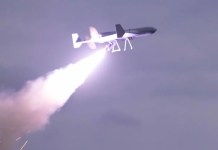In what could pose a fresh challenge to the French Rafales, the US government has allowed Boeing to sell F-15EX fighters to India. With this, the US aerospace giant has launched a renewed attempt to impress the Indian Air Force with its potent multi-role fighter.
Did The US ‘Smuggle’ A Russian Missile Defense System Out Of Libya By A C-17 Globemaster?
News agency Reuters quoted Ankur Kanaglekar, director, India Fighters Lead, Boeing Defense, Space & Security, as saying that “Now that we have the marketing license, it allows us to talk to the Indian Air Force directly about the capability of the fighter. We have started doing that in a small way.”
In a statement released on Thursday, Boeing said it will focus on its partnerships with India’s armed forces and highlight the strategic investments the company has made to develop India’s indigenous aerospace and defence ecosystem.
At upcoming Aero India 2021, “Boeing will feature a range of advanced capabilities including the F/A-18 Block III Super Hornet, F-15EX, KC-46A, AH-64E Apache, P-8I, Chinook, 737-10 and 787-9,” the US aerospace behemoth added.
Boeing has been pitching for the much-coveted 114-fighter tender by earlier offering its F/A-18 E/F Super Hornet to the Indian Air Force and the Indian Navy.
The company said it was going to highlight its F-15EX fighter capabilities at the exhibit, which according to Boeing, is the latest and most advanced version of the combat-proven, multi-role, all-weather day/night F-15 aircraft family.

“The F-15EX can offer a future-ready, multi-role solution to the Indian Air Force in the form of unmatched payload, performance, and persistence by integrating leading edge technologies, networks, and weapons and sensors,” the company statement said.
Experts are predicting a possible faceoff between the Rafale and F-15EX in India, as both compete for the mega fighter deal offered by the country. The F-15EX is said to be the most advanced US fighter offered for export after the F-35. The two aircraft were contenders for tenders in the 2000s in Singapore and South Korea. Interestingly, the American F-15EX won both the bids.
Although the F-15s originated back in the 1970s, the new modern Eagles boast stronger airframes, more powerful processors and flight control systems. The F-15EXs ordered by the US Air Force come with advanced radars and other subsystems and it’s unclear whether other countries will get those capabilities.
“The new airplanes would have a substantially more powerful mission computer, new cockpit displays, a digital backbone, and the Eagle Passive Active Warning Survivability System (EPAWSS) – an electronic warfare and threat identification system,” according to the Air Force Magazine.
The popularity of the F-15s continues around the world, mainly because the fighter has never been defeated in combat, which offers significant advantage especially when the enemy isn’t flying an F-15.
The fourth-generation fighter F-15EX is much larger than the Super Hornet and Rafale when it comes to weapons load capacity. With a maximum take-off weight of about 36 tons, the fighter comes close to the capability of IAF-operated Su-30MKI.
According to Boeing, the F-15EX can carry over 13 tons of weapons and fuel under its wings and fuselage, while Rafale has a payload capacity of only 9.5 tons.
The conformal fuel tanks in F-15E and F-15EX variants also help them to increase range and advanced navigation equipment for low-level ground-attack missions.
Most importantly, a single F-15EX can carry up to 22 air-to-air missiles, which is far more than any fighter in production now.
The US Air Force in July last year said it had awarded Boeing a contract worth $1.2 billion for purchasing eight F-15EX fighters. The force plans to buy 76 F-15EX fighters over five years, though this number could go up to 144 jets. Another country planning to induct the fighter is Israel.
Boeing also said it continues to keep the F/A-18 Block III fighter too on the table. “The Super Hornet’s unique differentiators for the Indian Navy include its two-seater carrier-compatibility capability which provides operational flexibility, and opportunities to integrate future technologies related to manned-unmanned interface from aircraft carriers.
“The F/A-18 Super Hornet recently successfully concluded ski-jump tests at Naval Air Station Patuxent River, Maryland, demonstrating its compatibility with Indian Navy carriers,” it said.
In addition, the aerospace giant announced an initiative called Boeing India Repair Development and Sustainment (BIRDS) hub that envisions a competitive MRO ecosystem for engineering, maintenance, skilling, repair and sustainment services of defense and commercial aircraft in India, as part of its commitment to supporting and strengthening indigenous aerospace and defense capabilities in the country.
According to the company, the initiative is a first that will benefit Indian customers with best-in-class solutions, efficient turnaround times, and optimal economic value, all available in-country.
The BIRDS Hub will also focus on skill development programs that will help suppliers develop capabilities and gain experience across Boeing platforms.
The company also maintained that due to the significant impact of COVID-19 on the commercial aviation market, forecasts indicate that it will take around three years for air travel to return to 2019 levels and a few years beyond that to return to long term growth trends.
“India’s large domestic passenger market relative to total passenger travel (domestic and international) presents an opportunity for a quicker recovery when the COVID-19 pandemic abates. India is expected to grow at a world-leading compound annual growth rate of 5.2 percent through 2039. This is mainly contributed by the rapidly growing middle class in India,” it said.




